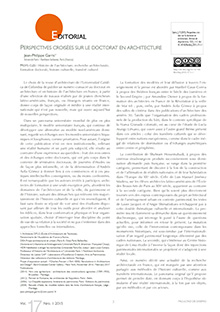
Revista de Arquitectura is an open access journal. More information...
Authors retain copyright and grant to the Revista de Arquitectura the right of first publication, which will be simultaneously subject to the Creative Commons (CC) BY-NC license.
Authors will sign a non-exclusive distribution license for the published version of the article by completing (RevArq FP03 Permission to Reproduce).
Self-archiving will comply with SHERPA/RoMEO guidelines and the Green classification.
To see in detail these guidelines, please consult...
Abstract
The decision of the Architecture’s Magazine at Universidad Católica de Colombia, dedicated to publish a doctoral research in architecture and architectural history in France, through a selection of works by young Latin American researchers, French and foreign residents in France, materializes in an original and unprecedented way an international reality that even without being innovative, actually opens up new perspectives. In an increasingly multipolar world university landscape, the French university model, continues to develop an alternative to the dominant American model, by including exchanges with Latin American and Portuguese-speaking university settings as a priority. And yet, showing a human reality and a subjective bias, we find the origin of this issue has not been institutional but arises, however, as a daily experience: this is the result of meetings between PhD’s made in the context of doctoral seminars, study days and more informal exchanges as well as the determination of Andrés Ávila Gómez to realize this type of convergent intellectual practices and compared, above all. Notably, those invited to participate -Architects, with one exception-, address fields of architecture and town, heritage and history, following their own approaches to cultural history, and recognized here. Undoubtedly, it is important to note that candidates also have all the tools to analyze the buildings both in its physical configuration and its spatial structure, and to choose the way the discipline itself is questioned from the perspective of their relationship with society, without limitation formal or internalists approaches. The modeling and dissemination through education and the media is approached by Maribel Casas Correa in the case of the French theater of the Enlightenment to the Second Empire; by Amandine Diener concerning the training of architects in France from the Revolution to the eve of May ‘68; and finally by Andrés Ávila Gómez in the case of cinemas in architectural publications in the thirties. On the other hand, the organization of professional construction managers in the specific context of colonial New Granada, is the core of study by Lucia Arango Lievano, opening another fundamental issue that is present in this series: the cultural transfers that take place between European nations and also in the context of unequal relations of domination or asymmetric exchanges between center and periphery. Shahram Hosseinabadi’s text, which deals with the Strasbourgs cinemas produced successively under the German and French domination, falls into the first category, simultaneously questioning the construction and affirmation of national realities in Europe in the twentieth century and their hybridization. Luis Manuel Jimenez Madera deals in his text-which falls in the second category-with the Latin American students in architecture within the Ecole des Beaux-Arts in Paris in the XIXth century. Although more precisely oriented towards contemporary issues of architectural design and urban planning in the heritage context, Laure Jacquin and Angie Shimabukuro’s texts do not escape this double cultural and international issues. Jacquin clearly fits her diachronic approach problematic from current questions, then interrogates the past to guide the present; for it addresses the contemporary intervention in historical monuments, considering it as a today’s transformation is based on the internationalization of the heritage perspective, which for a long period of time was defined by national frameworks. From another angle, Shimabukuro, by treating the historical center of Lima, explores ways in which international guidelines on equity are projected and adapted to specific local conditions.Thus, this magazine describes the present research in architecture in France, marked by shared care on methods of cultural history and international transfers. The original perspective that this number intends materializes the suggestive hypothesis of an international reality that encompasses methods as well as both objectives and actors.

References
Garric, J. P. (2015). Perspectives croisées sur le doctorat en architecture. Revista de Arquitectura, 17(1), 3-5. doi:10.14718/RevArq.2015.17.1.1
































